









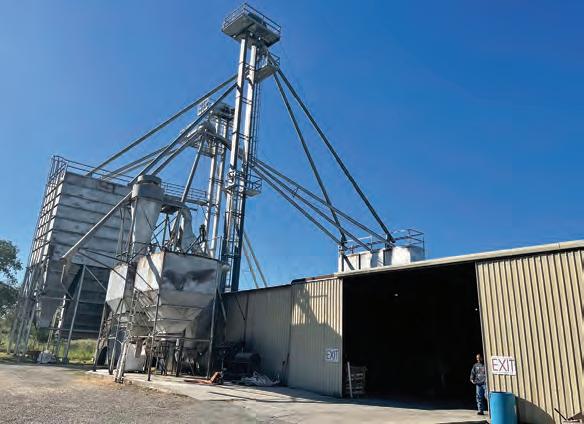




TRACKING / GUIDE SERVICES

RESTAURANT/SPECIALTY FOODS
REAL ESTATE
OUTDOOR ACCESSORIES
EVENTS/ATTRACTIONS
HUNTING RANCHES

























elcome to the 2025-2026 deer season! As you prepare, be sure to brush up on all the hunting rules and regulations. Lately, I’ve been fielding an increase in calls on drone usage. As a reminder, it is unlawful to use aircraft (including drones, except by activity-specific permit) to hunt, locate (including wounded animals), manage, harass, drive, trap, or photograph any wild animal. Use of drones to locate wounded animals is NOT permitted. Additionally, please note the importance of ensuring compliance with the hunter education requirement. Every hunter, including out of state hunters born on or after September 2, 1971, with the exception of military and law enforcement exemptions, must show completion of hunter education.

Hunter education courses are taught locally each year at the Claud H. Gilmer Memorial Library in Rocksprings, through the Texas Youth Hunting Program (TYHP). Participants have the opportunity to learn and discuss what is legal, ethical, and safe with the TYHP instructor and the Edwards County Game Warden. Good luck this season! I’ll see you in the field.
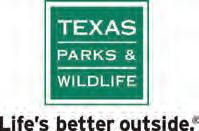




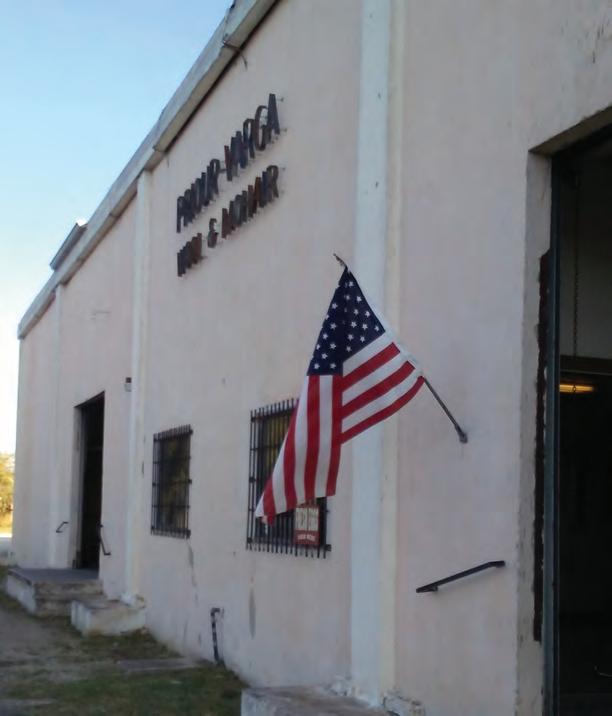














By Macy Ledbetter
This article is aimed to help you answer this question based on conditions stemming from the results of many, many hours spent in a helicopter counting deer this year. As wildlife biologists, we get this question all the time and the answer this year can be found below.
Without survey data, you really are guessing. You could guess correctly, or you could guess wrong. Wrong decision results can last for five to six years, so make sure you have more data than less to ensure quality hunting experiences for the foreseeable future. So for low fenced, unmanaged properties with limited survey data, here are my recommendations for buck harvest this year:
There is a large cohort of yearling bucks this year because we had a good fawn survival last year. On a low fenced scenario I cannot think of a situation to harvest any yearling bucks this fall. Roughly one quarter to one third of your yearling age class are spikes this year and they struggled late winter and early spring just to survive, and some did not. Do not remove a quarter or more of your yearling bucks by shooting spikes this year, let them get older before passing judgement. Life is hard as a yearling buck so don’t make it any harder than it is.
Large in overall numbers and with a wide range of antler quality this year, make sure you know what you are shooting at to ensure it is not a great yearling buck instead. I rarely recommend harvesting two year old bucks since aging them is difficult so look at the three year olds instead.
Harvest those bucks missing one or both brow tines or with frames you don’t like, but know the more middle-aged bucks you harvest, the fewer mature ones you will have. I recommend harvesting no two year olds and only the worst of the worst three year olds and then only sparingly.
This age class is abundant this year and they are fat and healthy. If these are the oldest bucks on your ranch, they might surprise you because this cohort of bucks are overall very good. Harvest those bucks with less than ten mainframe points and go very lightly on trophy class harvest with those having ten or more points because they are going to be really big with more age. We need to save some quality seed stock for the future and some of the top end four-year-olds are big this year. If your hunting lease restricts trophy buck harvest to five years old or older type bucks, you better have good optics and be very careful before pulling the trigger this year because antlers can be deceiving and there are some large four year olds this year.
Huge bodies, wide backs, thick neck, dark antlers but not real abundant this year. Bucks get large antlered at five and usually grab your attention when they first appear. Make sure all the bucks in your herd have large frames and good tine length or take them out. There are some outstanding mature bucks available this year and many have forks, kickers and sticker points.
Meat hunters, please do not shoot, for any reason, an immature buck that does not fit in the age criteria listed above and repeat the sappy story about needing meat to fill the freezer. You will have passed multiple does to select for that one buck, so I don’t buy it at all and neither does the landowner.
If you really and truly need just meat, I can’t think of a single reason why you have to shoot a buck to do it. Instead, select the oldest doe in front of you without a fawn present this year. Does without fawns this year are butterball fat and will easily fill your freezer so locate them early and take them early in the season to ensure the best venison you have ever eaten before. If you have quality survey data and specific harvest recommendations, obviously follow those as close as possible. If you do not, take my advice above and make the deer herd as good as it can be under your situation. Do your part to improve the herd and the habitat and make the correct decisions this fall.









By Macy Ledbetter
Central Texas wildlife is coming to the end of 2025 in very good overall condition. Despite the later winter and spring drought and mid-summer flood, the native wildlife made it through in pretty good condition. Starting in June, the rains were favorable for the most part and well timed with overall milder summer temperatures. The brush is currently in great shape; the grass is tall and local hay producers have been very busy.
As you likely know, I spend every single day in the field starting in August looking, counting, photographing, monitoring, measuring and judging wildlife and habitat conditions throughout my travels. The entire month of September finds me in a helicopter all over central Texas primarily counting deer, turkey, quail and shooting predators, so I get to see some incredible wildlife on incredible ranches up close and personal covering a very large area and many, many acres.
The native brush and trees are amazingly hardy; however, you will see many dead trees this year. The two ice storms a few years back, combined with back to back droughts really impacted our big trees---primarily Post Oak, Live Oak, Hackberry, Cedar Elm and Pecan and all are very important to our wildlife species.
The following are my 2025-2026 hunting season forecast for Central Texas based on our company’s recent helicopter and thermal drone surveys and landowner meetings throughout the general area:
The area-wide fawn survival average this year is 60%. However, it ranges from 50-80% and that variable is grass in May. If you had good grass on your ranch back in May, you are in the high end of that range but if you saw more rocks than grass, you are certainly on the lower end, despite the tall grass now. This means if your fawn survival is low, you need to make certain you know your herd dynamics before you start shooting deer this fall. And for sure you need to harvest the correct deer this fall to ensure production will continue next summer.
Antler quality and body condition are just above average this year. There is a strong cohort of three, four and five year old bucks this year and there are some very nice bucks out there. There are far fewer six plus year olds this year. We saw above average numbers of kickers and forked tines this year and it is always fun to see those unique animals.
For the second consecutive year, turkey production has increased. The freezes and droughts that impacted the trees nearly devastated the turkeys too. Last year was the first year in five years of positive gains and this year is another positive year, so the
numbers are slowly increasing but nothing approaching historic levels. Turkey hunters looking for trophy long beards will have to hunt hard this year to be successful, but if simply harvesting a turkey is on your radar, you might have an opportunity this year due to all of the young birds available.
I was born and raised in northern San Saba County and I remember the 1980’s very well. We hunted quail often and success was very high. I am not sure if we can ever return to such quail densities as the 1980’s, however, quail are improving for the third consecutive year in a row now. Every ranch I have flown so far this year has increased quail numbers from last year and last year beat the year prior. Covey size is as large as in the 1980’s with 12-24 birds, however, most birds are young. There are two distinct age classes of birds, meaning two clutches were successfully raised this year. So I am not sure about huntable numbers in general terms, but some ranches certainly do have surplus birds this year for the first time in a very, very long time.
Rabbits are a “boom or bust” species, meaning when times are good, they do good and when times are hard, they don’t do as well. There are both cottontail and jackrabbits in surplus this year and you will certainly notice the increase of both. Rabbits do not over winter well and the migratory hawks are moving in right now, so their numbers will begin to drop weekly, but know it was a great year for both rabbit species. If you haven’t tasted a cottontail rabbit in a few years, this winter might be a good time to put it back on the menu and teach the kids in camp just how good they can be, especially with some gravy and mashed potatoes!
Speaking in general terms once again, feral hogs did suffer from the spring drought conditions. Sounder size is down this year as sows struggled to raise their normal litter size. We conduct many feral hog aerial shoots after game surveys and what we observed and harvested was way down from a typical year. Continue to do your part to help the other wildlife and native grasses and shoot as many feral hogs and as often as you can this fall and winter.
Most predator species (coyote, bobcat, fox) had a very good year this year. Our surveys and aerial shoots show the numbers are up across the board, especially coyotes. There are many coyote pups out there this year, the female appeared to raise all three or four pups this summer so do your part this fall and harvest predators when and as often as you can. Raccoon numbers are up significantly too so reducing their numbers will help save you protein feed and minimize ground nest predation on quail and turkey nests.
If your property, lease hunters or you need assistance and you want to improve the wildlife herds and/or their habitat on the ranch, give us a call because that is all we do and what we do. We work in every eco-region in Texas, have trucks and will travel and we can make your ranch better. Enjoy this time with friends and family, never forget those that we have lost since last year’s campfire and do your best to introduce a child to hunting this year.






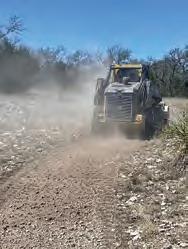






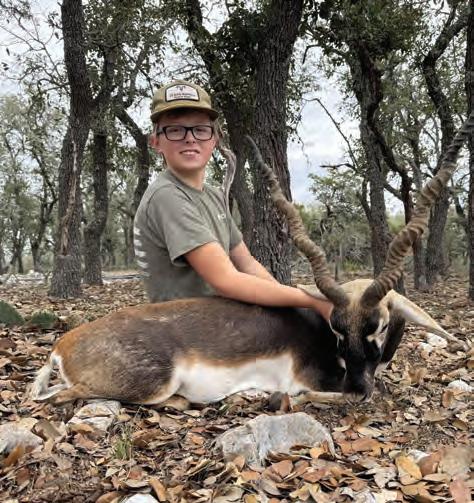








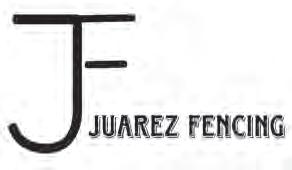







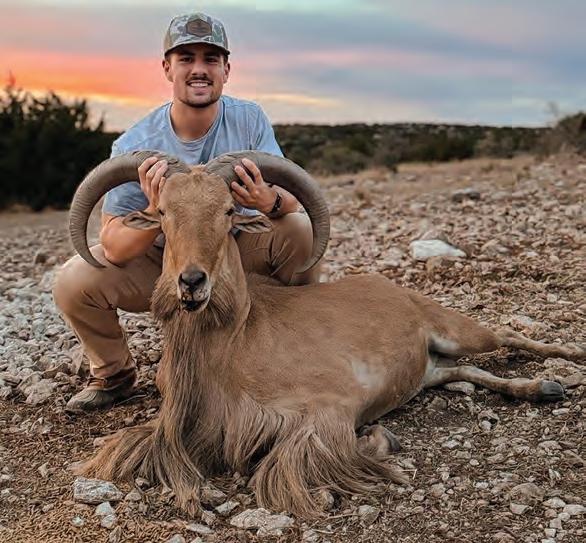



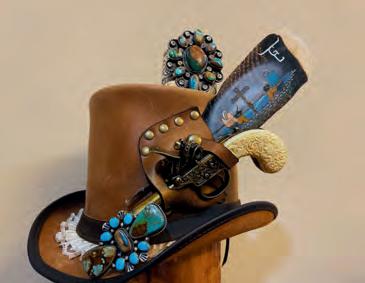


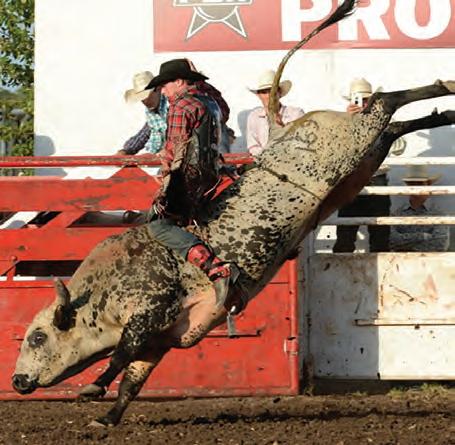

























By Macy Ledbetter
Ioften get asked about whole seed cottonseed as an alternative whitetail deer feed. It has gained in popularity and use and here is what you need to know:
Pros: Cottonseed is readily eaten by whitetail (and mule deer and several exotic species) and is very high in crude protein. It is high in fat and oils, is high in digestibility and protein, and little else will eat it such as raccoons, feral hogs or javelina. It increases weight gain and body condition quickly, especially in post-rut stress periods so that fetal and antler develop begins sooner and stronger.
Cons: Availability and distribution are not widespread and commonplace yet. Supply depends on cotton production; however, new developments have cottonseed in bags, totes and even large round bales. The bales are very easy to load, handle and use.
For more information on the baled cottonseed, visit www.CottonseedBale.com. Feeding cottonseed using the round bales is easily done by rolling it off of your trailer or out of the bed of your truck, quickly wrapping a pre-made wire cage around it and using your knife to cut the plastic roll off—quick, easy and very effective.
Some folks complain about the physical handling required of bulk cottonseed, but the bags, totes and bales are now solving those issues once and for all.
Outback Feeders (www.outbackfeeders.com) has built a new, bulk, timed cottonseed feeder that holds upwards of 1,000 pounds and offers doors that open and close on your predetermined timeline, a huge game changer to prevent nocturnal use and keeps it off of the ground, dry and organized.
The timed feeders are solar charged, battery operated and make feeding cottonseed much cleaner and more efficient for sure and put the animals on your timeline instead of theirs. So if you want to use cottonseed in your deer management program, the primary hurdles have been solved, and you have options on how to use it.
Finally, cottonseed can, in rare scenarios you may have heard about, create a condition called gossypol toxicity. Gossypol is a chemical found in the seed that will render male animals sterile. Yes, sterile, as in no babies made that year but this condition is temporary, and it usually affects those animals on extremely poor ranges or in severely overstocked populations.
The gossypol will leave the animal’s system once cottonseed is removed, and fertility will return in time. Overgrazed or overstocked ranches that feed cottonseed should stop feeding it, as the bucks remove the velvet from their antlers.
This timing gives the gossypol enough time to pass though the buck’s system and leave before he begins producing live sperm. Remember: the only time a buck produces live sperm is while he is in hard antler.
If you have quality soils, quality browse plants and maintain your density under the carrying capacity of the native range, gossypol toxicity will not be a concern, it only affects severely stressed habitats where animals have few choices of what to eat.
Cottonseed is a great feed to help restore body condition after a hard winter and for providing a great platform to growing antlers. It is not considered a complete feed but can work well in conjunction with a balanced protein feeding program. I recommend to those that ask to use both protein feed and cottonseed in unison to offer your deer the maximum groceries they can consume so that nutrition is never lacking.







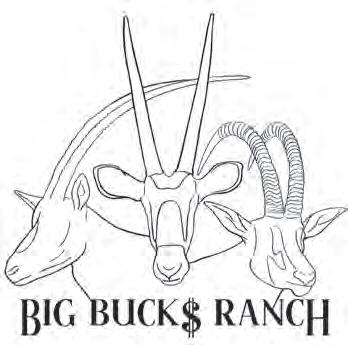




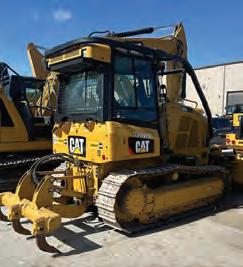
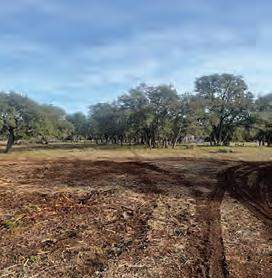

By Colton Stabeno
There are a few hunts that I apply for every year that I have zero expectations of ever drawing. At the top of this list would be all big horn sheep hunts. Right under the big horn sheep hunts is a hunt in New Mexico that occurs on the White Sands Missile Range. Oryx, specifically gemsbok, provide a once in lifetime opportunity to draw a hunt for these amazing animals. Odds for drawing this hunt are slim, hovering around one percent. You can imagine my shock and surprise when I eagerly opened my NMGF account to check the results of my applications and found a green bar for the oryx hunt, indicating I was successful in drawing a tag!
My 2024 draw year would be one for the books. In total, I would draw an Arizona bull elk tag, a Nilgai hunt at the Laguna Atascosa, an antlerless hunt at Colorado Bend State Park, and lastly an oryx hunt in New Mexico.
As mentioned, this tag is considered a once in a lifetime tag; New Mexico does not allow individuals to apply again to the hunt once drawn. This would likely be my only opportunity to ever hunt these magnificent animals.
I began receiving emails from the hunt director congratulating me on the drawing and providing important information pertaining to the hunt. It was echoed multiple times about how tough these animals were. Knowing that, I knew I would be bringing my Sako 300 Win Mag on the hunt.
My hunt would occur in February of 2025, so I had 10 months to dream about it. It was hard not to get excited. Success rates were high, and animals were abundant on the range. After what seemed like an eternity, the day had finally come to depart for New Mexico.
Since I was allowed a guest, my brother Hunter decided to tag along for the experience and provide an extra set of eyes when glassing. We left early Thursday morning and made the trek without issue. The hunt dates ranged from Friday, February 21 to Sunday, February 23. In some circumstances the Friday hunt is cancelled due to ongoing military operations. Thankfully, this was not the case for our hunt.
We awoke Friday morning anxious to get the day started. Check in was at 10 am, and we arrived shortly after 9 am to get in line. There would be 63 hunters total on this hunt, with only four of them being nonresidents. The check-in process dragged out till after noon, as they discussed all the rules of the range to which we must strictly adhere.
Having no insight or prior knowledge of the range, I decided to hunt the southwest area based solely on intuition and limited e-scouting. As they finally released us to hunt, we headed straight west to this location.
Not 10 minutes in this area, Hunter asked for me to stop so he could check something out with the binos. I looked out my window to see an oryx standing 200 yards from the road.
Shocked we had found one so quickly, I sternly demanded the binos back and glassed the oryx up. My initial thought was that he was a younger, smaller bull. However, when he turned his head, his horns swept back and proved to be longer than I first thought. While stressing about the decision to shoot or not, the bull begin slowly moving along.
Still unsure about my decision, I pulled up to another road and parked to make a stalk for a better look. I was able to stalk up to 200 yards for a better view of the bull but still decided against shooting. As we continued driving, I spotted the bull about 340 yards away once more. I bet I sat there for 30 minutes stressing about the decision once again. I finally decided against shooting the bull and continued. Not 10 minutes later, Hunter spotted a group of oryx more than 800

yards away. We drove up to the next road crossing and decided to exit the truck and attempt a stalk on this group. This stalk provided fruitless as they were nowhere to be found. We decided to finish the afternoon hunt by scoping out another area just north of where we were. As we drove down the road, I spotted a pair of gemsboks roughly 600 yards out.
As my binoculars found these bulls, I was immediately assured that I had made the right decision in passing on the bull from earlier. These two were giants! Unfortunately, they had already spotted us and were on the move. Given the road conditions and direction they were headed, I knew there would be no opportunity to catch up with them. I admired the pair till they were out of sight, then headed to the checkout station.
Saturday morning came early but started with much anticipation and excitement. We popped out of bed and got dressed, then indulged in a fancy Super 8 continental breakfast (said in jest).
We arrived at the gate and waited for them to turn us loose. Our plan was to head right back to the area that had treated us so well the evening prior. As we made our way through the gate and began the 30-minute drive west, it was just getting light enough to see.
About halfway to our destination, I catch movement to my left. A broken horn oryx comes running across the road. I pulled over to glass him for entertainment, then continued. Arriving at our area, we began slowing driving along roads, stopping to glass ever so often.
Heading up a long gravel road towards the mountain range on the west, I spotted a pair of bulls about 800 yards out. As I found them
See ONCE IN A LIFETIME, page 24

“I have been an investor in real estate for many years. After buying land and establishing an exotic game ranch where I live full time, I have spent the last few years turning raw land into turn-key ranches for others to enjoy. My love for the hill country land created the desire to explore real estate as an option to help others find their dream ranches. My experience in ranching and real estate is the perfect combination.”


in the binoculars, they were aware of our presence and moving away. Assuming my only shot at these animals would be on foot, I jumped out of the truck and began working my way towards them.
I took an angled approach to head them off, using what little topography and brush I could to conceal my movement. Arriving at what I assumed would be their current location, I hastily scanned the area looking for the bulls. I finally located them, only 800 yards past where I was and steadily moving away.
Baffled they were so far away from me, I decided once more to try and catch up to them as they had just crested a ridge that would fully conceal my approach. Moving as quickly as I could, I reached the ridge where I eventually found the bulls even farther away. I capitulated at this point and headed back to the truck. We decided to head north to check out some of that country in hopes of turning up some oryx.
For hours we drove around the northern part of the unit scouting for areas to hunt. There seemed to be many more hunters in this area of the unit compared to where we were hunting previously. My constant mindset on any hunt is to always get away from other hunters, so we decided to head back to the area we had been hunting. At this point my spirits were in the dump.
I was regretting passing on that bull from the first day, and fearing that the possibility of going home without a Oryx was becoming a real possibility. As we arrived back at the southwest corner of unit, we decided to ease up the long road we traveled up that morning once more. With my brother driving, I looked out his window to the south and took interest in a series of rolling ridges. Eager to get my boots on the ground again, I decided to park the truck and take out on foot to hunt these ridges.
With my tripod in one hand and gun in the other, I slowly traversed these ridges with my brother in tow while frantically searching every square foot of area. Approaching the last ridge, my eyes locked on to a lone oryx standing ahead and to my right. I quickly folded my tripod out and set my rifle on top.
Considering how the day had progressed to this point, coupled with the fact that I strongly preferred not to take this hunt to Sunday, I decided to shoot without much consideration for horn length. I did reason that this was a bull based on his body size.
I reached for my range finder only to discover I had left it in the truck. With intuition guiding me, I guessed the bull at a little over 300 yards. Since my Sako was zeroed at 200 yards, I figured I would just hold a touch high.
Settling behind the scope, I quickly realized that making a good shot at this animal would be nothing short of remarkable. For starters, my tripod was not high enough causing me to slightly squat to get level. Also working against me was the uneven, rocky terrain that had both myself and the tripod off balance. Sprinkle in a pounding heart with adrenaline coursing through my veins, and I was doing good just to keep the crosshairs on the animal!
Knowing I was operating on borrowed time as these animals were quick to disperse, I took a deep breath and squeezed the trigger the moment my crosshairs were lined up. The recoil of that light weight Sako provided quite a kick, but I was able to see the oryx react to the shot, an indication that he was hit.
Although the shot felt good, I was nowhere near confident in the shot given the less-than-ideal set up. The oryx blew out of there and was over the ridge in an instant. Hunter caught up to me, and I gave him the quick rundown of the situation.
We quickly headed towards where the oryx was at the shot. We decided that Hunter would look for blood on the ground as I would keep my eyes forward and ready for a follow up shot. Hunter immediately found blood, and judging from the amount of it things were in our favor!
The blood trail was easy to follow, and we began covering ground
quickly. As we approached the last draw, I peered down into the bottom to see the most incredible sight of the bull lying dead there! I burst out with a “there he is” prompting a spontaneous celebration between us. Even from 75 yards away, it was easy to see how big of an animal he was. Walking up and putting my hands on him left me in complete awe. I had never seen such a beautiful animal up close like this. His horn length was nothing extraordinary, but I speculated he would be right at that average mark of 33”.
We took time to take some great pictures of the animal, exercising care as to not break the rules that the military base imposed on pictures. Looking at the time, it dawned on me that we had better get to work asap if we were going to make it out of there on time. We were only about ¾ of a mile from the truck, but the amount of rocks and ridges we had to cover would make the pack out no easy feat.
Being as I wanted to shoulder mount the bull, I had to take care in caping the animal. As the minutes ticked by, I quickly realized it was going to be a race against time to make it to the checkout station before the deadline. We had orders not to be a minute late past the mandatory 7 pm check-out. As we finally got the bull caped and quartered, we loaded up our first load of meat and headed to the truck. With adrenaline fueling us, we made short order of the first pack out.
We dumped the meat in the cooler and immediately headed back in for the second load. Finally arriving back at the truck with the pack out complete, we had 45 minutes to make it to check out. With a strict speed limit of 55 mph, we made our way east. With only four minutes to spare, we pulled into the checkout station. The biologist there measured the mature bull at 34” in horn length. We thanked the staff for providing an unforgettable experience and bode the White Sands Missile Range a farewell. A DIY gemsbok hunt on government property is not something I ever anticipated doing, and I am forever grateful for the opportunity.

Lord, I love the great outdoors, enjoying this great world of Yours. Thank You for the fields and streams, because they’re every hunter’s dream.
Lord, I am blessed to be Your child. Protect me when I’m in the wild. Today I ask and humbly pray, That I will have a fruitful day. Amen A Hunter’s


By Macy Ledbetter
What, exactly, is the rut in whitetail deer and why do hunters enjoy it so much? What causes the normally secretive and elusive mature bucks to temporarily lose their minds and wonder out into a wide open field during the hunting season? Let’s take a deeper look into the science and biology of this incredible, annual, phenomenon hunters call “the rut”.
The drive of self-perpetuation is a strong one. It is more than just “survival of the fittest” and includes a myriad of hormone and chemical responses throughout the body triggered by nutritional and environmental factors alike.
Assuming the animals are healthy, let’s look closer at exactly how the rutting behavior happens.
Courtship: Running is a large part of the whitetail’s courtship behavior. Bucks travel great distances in search of females that are nearing receptiveness, or estrous.
They use their nose exclusively to determine if a doe is getting close as they travel from doe group to doe group in search of a potential mate. During this time, bucks may lose up to 30% of their body weight as they feed and rest rarely during such extensive travels. The females that are nearing estrous, but just not quite ready yet, will run from the buck’s asserted charges.
At first a trot, her fawns will usually follow as they can. As her receptiveness increases, the chase tends to resemble a track meet and the fawns are usually then left far behind. As the receptiveness of the doe peaks, the chase slows down and the two spend more time closer together, even bedding down together at times.
Once the doe is completely receptive, she will stand for the buck and allow him to rest his head on her rump.
Soon thereafter, copulation takes place but lasts only a few seconds. After mating, the pair split up and the buck begins the same cycle over and over again. In a nutshell, the peak of the rut is simply the period when most of the females are in estrus and the healthy mature females dictate the timing of the rut.
Timing: The timing of the rut depends on your general location, or latitude, where you hunt. Except near the equator, the rutting season is tied to the photoperiod, or day length. The diminishing ratio of daylight to darkness triggers the start of the reproductive cycle each year in both sexes. Because photoperiod is tied to latitude, the rut progresses in North America from the north being the earliest and the south being the latest. In a nutshell, photoperiod triggers physiological changes that lead up to the rutting activities.
Nutrition: Because the actual rut peak is dictated by adult females coming into estrous, the nutrition and body condition of the females in the months proceeding up to the rut plays a key role in the exact localized timing.
Weather and temperature also are factors, but once the photoperiod has prepared the females physiologically for breeding, cooler weather and a drop in the barometer certainly helps in getting the deer on their feet more often.
Unseasonably warm weather suppresses rutting activity. Obviously, a body that is lacking from adequate nutrition cannot and will not function properly. In this scenario, females fail to enter heat, or estrous, and therefore can’t get pregnant or cannot maintain their pregnancy which ends in the same result.
The males can’t maintain the physical strength or their hardened antlers long enough to participate and thereby cannot contribute to the gene pool.
Biology: In both sexes, a pea-sized gland near the center of the
brain is called the pineal gland and it receives input from the eyes that triggers the release of a hormone called melatonin. As the days become shorter in the fall, more melatonin is secreted and this increased melatonin acts on the pituitary glands and regulates the release of a host of different hormones.
Such annual cycling is responsible for the different hair coat changes, food intake levels, antler growth cycles, ovulation and timing of the overall rutting activities. If the pineal gland is damaged or interrupted in any way, the timing of these natural seasonal cycles are compromised.
In females, follicles in the ovary produce estrogen—the hormone responsible for the doe’s mating urge. Another ovarian hormone, progesterone, acts with estrogen to promote optimum heat—or the time when a doe will permit actual copulation.
The rise in estrogen eventually causes the release of a mature ovum for the buck’s sperm to fertilize.
In males, the testicles are separated into three production phases: primary development, full production and resting. The phases are directly related to the onset of antler growth, the shedding of velvet, and the antler casting period.
The growth and sex hormone, testosterone, is produced to begin live sperm production. Viable sperm production, measured in the billions per ejaculation, increases slowly up until the actual peak of the rut and then begins declining as the mating season ends.
Sperm production and testes size are greatest in males aged three to seven years of age, however, buck fawns, given the chance, can successfully impregnate females. Testosterone dictates the course of antler development, so any damage to the testicles during any stage of the antler growth process will usually result in the antlers being held in limbo and may cause severe deformities or a permanent velvet stage to remain, regardless of the season.
Now you know how and why the rut begins and what triggers and controls it.

Macy Ledbetter is a professional wildlife biologist with a life-long passion for intensive wildlife and habitat management. Macy earned his degree from Texas A&M University and created the wildlife consulting business, Spring Creek Outdoors, based in central Texas on his historic family ranch. Macy is a fifthgeneration rancher and actively manages his ranch for optimum cattle and wildlife production. His client list totals over 3 million acres in all eco-regions of Texas. He understands and explains wildlife management processes like few others and can make each individual step palatable and educational for his clients. When he is not surveying wildlife, hunting, or writing about game management, he may be found supporting legislative projects or working as an expert witness in a wide array of legal cases. Macy and his wife Cathy live on their family ranch in northern San Saba County, along with a variety of pets. You can reach Macy anytime at Macy.Ledbetter@gmail.com. Photo courtesy Macy Ledbetter.





By James Bigley
Feeding white-tailed deer in various habitats and climates requires a strategic approach to meet their nutritional needs. Cottonseed and protein feed are two vital components that play a significant role in ensuring these animals reach their optimal health and genetic potential. Let’s delve into the benefits of both these supplements and how they contribute to a well-rounded deer nutrition program.
Cottonseed stands out as a valuable nutritional supplement, particularly in arid climates where green crops may be scarce. This feed provides a crucial missing link by offering essential nutrients that may not be readily available in the deer’s natural habitat. One of the standout features of cottonseed is its impressive protein and fat content, boasting over 20%. This high protein content is essential for deer, especially during critical periods such as post-rut.
Cottonseed helps in rejuvenating bucks quickly, aiding them in rebuilding their body weights. The sooner they recover, the faster their bodies can focus on antler growth, making cottonseed a great one-two punch when combined with a protein-rich diet.
Protein feed is a solid supplement for both native and genetic herds of whitetail deer. It plays a crucial role in helping deer reach their genetic potential, which can be limited due to the constraints of the native browse they typically rely on for
sustenance. Protein supplements compensate for the lack of nutrients in the native vegetation, enabling deer to achieve optimal growth and development.
However, it’s important to note that while protein feed is highly beneficial, it may not cover all of a deer’s nutritional requirements, especially when native vegetation is sub-par due to factors like inadequate rainfall. This is where cottonseed steps in, filling the nutritional gap and providing the essential nutrients that deer need for overall well-being.
In addition to protein and cottonseed, minerals are a crucial part of a well-rounded deer nutrition program. Providing minerals in the deer’s diet ensures they have access to essential nutrients for their bone development, overall health, and antler growth. Salt blocks placed near water sources or spread around corn feeders provide a convenient way for deer to access these vital minerals. Establishing granular mineral sites further supplements their mineral intake, allowing them to consume the necessary minerals as part of their regular diet.
In conclusion, cottonseed, protein feed, and mineral supplementation are vital components of a comprehensive deer nutrition program. Understanding their benefits and incorporating them strategically can significantly contribute to the health, growth, and genetic potential of whitetail deer in different habitats and climates. By providing these essential supplements, we can support the well-being and thriving of the deer population. Photo by Darlene Cabela.

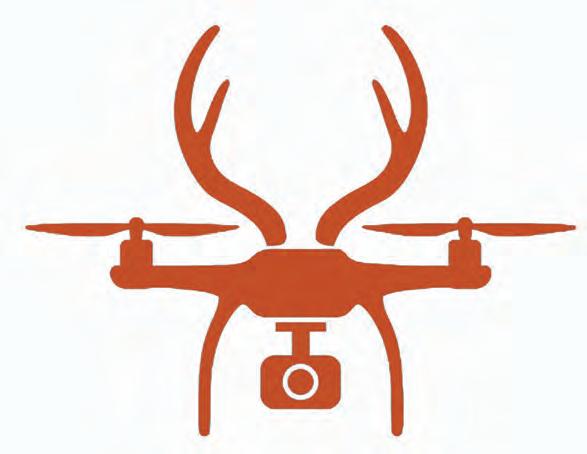



ROCKSPRINGS H Proceeds of this January 2026 raffle benefit the Edwards County EMS. Don’t miss out, check the Edwards County EMS Inc. Facebook page for details, coming soon, or visit the website at www.edwardscountyems.org

ROCKSPRINGS H Head on over to the Edwards County Senior Activity Center, where you can enjoy a home-cooked meal — served weekdays from 11 am to 1 pm (excluding holidays).
Guests ages 60 years and up are welcome to join for a dine-in meal at the center for just $5.
Edwards County Senior Activity Center is located at 104 E. Kerr (one block east of the school). For information, call 830–683–3722.




ROCKSPRINGS H Devil’s Sinkhole in Rocksprings is home to one of Texas’ largest colonies of Mexican free-tailed bats and is a National Natural Landmark. A 50-foot wide shaft drops 140 feet into the cavern, which itself has a diameter of more than 320 feet and reaches 350 feet deep.
Mexican free-tailed bats roost in the cavern from late spring through early fall. They migrate to Mexico for the colder months of the year. Each evening the bats begin a nocturnal quest for food, and some 3 million bats emerge in a swirling mass from the Devil’s Sinkhole in search of food on warm nights. Scientists estimate this colony consumes up to 30 tons of beetles and moths each night! Guests marvel at the amazing spectacle.
Bats are the main attraction at Devil’s Sinkhole Natural Area, but not the only one. Guests can also enjoy guided nature walks and birding tours through the 1,860-acre natural area.
Access is by guided tour only. Reservations are required. Bat tours led by the Devil’s Sinkhole Society are offered when bats are in residence. These bats are wild creatures, however, and don’t always conform to the humans’ tour schedule.
Tours launch from the Devil’s Sinkhole Visitor Center on the square in Rocksprings. Evening bat flight tours are Wednesdays through Sundays, May 1 through October 31.
Bats are wild creatures affected by natural factors; so there is no guarantee they will emerge on schedule. Tours take you to a wheelchair-accessible viewing platform over the sinkhole where you can peer into the depths of the shaft. Tour fees are $14 for adults, $11 for Seniors 65 and up and $6 for kids ages 4 to 12. Kids under 4 get in free.
The Devil’s Sinkhole Society also leads nature walks, birding outings, and day tours to view the sinkhole. Call to arrange these tours.
Photos and information courtesy TPWD.
FYI • Visit tpwd.texas.gov/state-parks/devils-sinkhole for upcoming event at Devil’s Sinkhole Natural Area. To schedule tours, and for more information, call 830-683-2287.




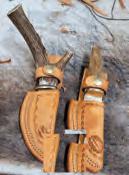
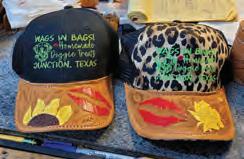



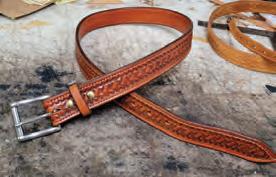









By Wade Ledbetter
As a hunter you’ve likely spotted coyote tracks crisscrossing your lease or found scat riddled with deer hair. Maybe you’ve even found kills, with deer gruesomely cornered, dissected, and stripped to the bone. Canis latrans, the cunning coyote, is a top predator that’s as adaptable as it is destructive to your quarry.
Weighing 20-40 pounds, these canine opportunists devour rodents, rabbits, deer, game birds, and even livestock, while snacking on prickly pear, mesquite beans, and corn meant for whitetails.
Their impact on deer herds is stark: they maim more than they kill cleanly, often leaving tailless survivors and messy kill sites marked by tracks and blood. Understanding their ways isn’t just trivia, it’s your edge in keeping populations in check for better hunting.
Coyotes are monogamous breeders, pairing up in February through March for litters of five to seven pups after a 63-day gestation. Dens hide in banks, crevices, or brush, with both parents raising the young until dispersal in late summer.
Packs revolve around the breeding pair, bolstered by last year’s offspring or wanderers. Creatures of habit, they stick to visible routes like ranch roads and ridges, with hunting activity peaking at dawn and dusk. Bedded in grass by day, they rely on razor-sharp smell and sight to hunt and evade.
Coyotes are quick learners and will become forever trap-shy if they escape from a close call. Their predation ramps up in summer, when pup-rearing spikes hunger and fawns abound.
Studies show that 40 percent of their summer diet is made up of whitetail fawns, and coyote mothers have been recorded bringing 5 or more fawns per week back to the den. Coyotes are a leading cause of natural mortality in bucks during late winter, when bucks are weakened from the rut and vulnerable to predation.
Lethal control is a proven fix for the impact of coyotes, as in trapping, snaring, and shooting, year-round. Some of my clients have seen their fawn survival rates increase up to five times over after implementing diligent predator control practices.
Ranches bordered by net-wire fences can be snared year-round,

and when done correctly snaring can ensure that the ranch is kept coyote-free for years at a time.
Properties that are already infested or have more porous fencing can make huge gains in fawn survival by aggressively hunting and trapping coyotes leading up to the fawning season. February and March yield the best results for aerial hunting since coyotes are very active then, but trapping and calling up to May and June can give fawns the breathing room they need to thrive.
Remember that every trophy buck starts life as a vulnerable fourpound fawn, so protecting fawns is the first step in bagging a giant.
Photos courtesy West Kerr Ranch, Mountain Home.
Wade Ledbetter is a professional wildlife biologist and member of the Spring Creek Outdoors, LLC team. He grew up both in the thornscrub of south Texas and on his family’s historic ranch in San Saba County. Wade has spent years in the family business working directly with landowners, conducting helicopter surveys and wildlife captures and has more hands-on experience with intensive wildlife management than most professionals three times his age. As a sixth-generation landowner, he is intimately familiar with the responsibility of landownership and intensive wildlife management. Wade received his Wildlife and Fisheries Science degree from Texas A&M in 2020, was a member of Company E-1 in the Corps of Cadets, and a member of the Corps Marksmanship Unit, where he helped win seven collegiate national shooting championships. When he is not counting or catching wildlife, Wade continues to shoot competitively and conducts private, intensive shooting courses for individuals, law enforcement, and shooting industry representatives. With his wife Macie, Wade lives in Mason County and can be reached at any time at wadeledbetter@me.com.
Photo courtesy Wade Ledbetter.















OCTOBER 31, 2025
DIVIDE: Divide School Annual Wild Game Dinner. 4 pm to 8 pm. Divide Volunteer Fire Department on Highway 41. $20/plate. Silent auction, $10 raffle. $5 raffle, bake sale, fellowship.
LEAKEY: Real County Wildlife Association Raffle. Drawing on November 1. Prize is Polaris RXR XP 1000 Ultimate. $100 per ticket/500 tickets available. Don 210-210-7085, Will 830-486-8892.
OCTOBER 31 - NOVEMBER 1, 2025
UVALDE: Annual Hunters Roundup & Texas State Championship BBQ Cookoff. Uvalde County Fairplex Rodeo Arena. hrubbq.org.
NOVEMBER 8 , 2025
SONORA: Sutton County Game Dinner. sonoratexas.org.
NOVEMBER 22, 2025
SONORA: The More the Merrier Christmas Bazaar. 10 am to 5 pm at Sutton County Civic Center. Photos with Santa and Mrs. Claus from 3 pm to 4:30 pm. sonoratexas.org.
ROCKSPRINGS: Edwards County Annual Hunter’s BBQ. Edwards County Fairgrounds. 6 pm to 8 pm. Raffle drawings start at 8:30 pm. For more information, edwardscountychamber@gmail.com.
NOVEMBER 29, 2025
JUNCTION: Kimble County Wild Game Dinner. 40+ guns and other prizes for raffle. Coke Stevenson Center, Highway 83 North. 6:30 pm. email kcwildgame@gmail.com.
DECEMBER 13, 2025
ROCKSPRINGS: Edwards County Junior Livestock Show. Spud Tatum Show Barn. Visit the website at edwardscountyjla.com or email edwardscountyjla@gmail.com.
JANUARY 22-24, 2026
UVALDE: Uvalde Country Junior Livestock Show and Sale. Uvalde Country Fairplex. uvaldecountryfairplex.com.
MARCH 21-22, 2026
UVALDE:: Texas High School Rodeo Finals, Region 8. Uvalde Country Fairplex. uvaldecountryfairplex.com.
MAY 1-2, 2026
UVALDE: Cactus Jack PRCA Xtreme Bulls. Uvalde Country Fairplex. uvaldecountryfairplex.com.
JUNE 26-27, 2026
ROCKSPRINGS: 97th Annual Edwards County Fair. PBR Bull Riding, dance under the stars Friday and Saturday nights, parade, goat roping, washers, cornhole, goat cookoff and more! EdwardsCountyFair.com.
JULY 4, 2026
UVALDE: Celebrate America 250th Birthday Party. Uvalde Country Fairplex. uvaldecountryfairplex.com.





















Family Ranch in Concan, Texas
Two Lodges sleep 15 each World Class Year ’Round Hunting
Native: Whitetail, Turkey, Hogs
Exotics: Axis, Blackbuck, Nilgai, Eland, Semitar



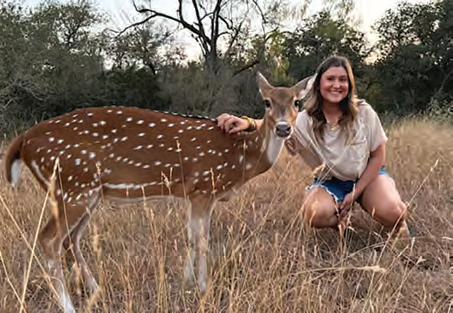
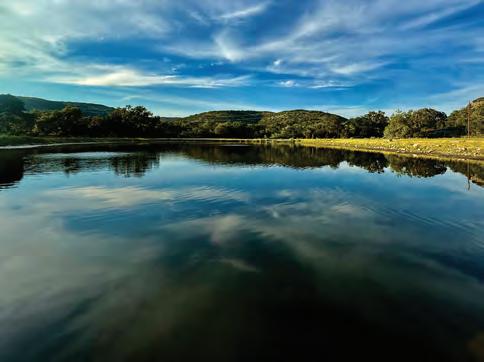


We are a family ranch dedicated to authentic Texas Hunting for hogs, turkey, world-record aoudad, and both low-fence and high-fence whitetail hunts. Nilgai hunts, blackbuck hunts, semitar-oryx hunts, eland hunts, red stag hunts, red sheep, ostrich and year-round axis hunts are also available.
We focus on quality, not quantity. We are well suited for family reunions, corporate hunts, corporate retreats, or groups of 3 to 10 hunters.
Comfortable accommodations. Each lodge is fully air-conditioned and offers 7 bedrooms, 16 beds, and 5 full baths with a full kitchen, large dining area, and game room. The game room features a pool table, shuffleboard, ping pong, lazorshot shooting range, and old-style video arcade games. We also offer chef service. The lodge has a large covered porch, covered dance floor, outdoor fire pit, pool/ spa, and amazing sunsets!

By James Bigley
Unless you’re from Texas or a hunter, I’ll bet you’ve never heard of Axis Deer. Originally from India and Sri Lanka, where referred to as Chital or spotted deer, they are thought by many to be the most beautiful deer. Their coats are rust-colored and covered with white spots, very similar to a Whitetail fawn. They are sizable, weighing in from 110-135 pounds, while bucks can weigh in at up to 200 pounds.
EXOTIC AND INVASIVE SPECIES
Texas has a current estimated population of up to 125,000 animals, according to the Exotic Wildlife Association. The highest populations of Axis Deer in Texas are now mainly found around the Edwards Plateau area. Axis Deer are grazers and will eat for food a broad variety of grass, forbs, and browse. This contrasts with White-tailed Deer, who are much more selective, eating predominantly forbs and browse (tender shoots, twigs, leaves of trees and shrubs, etc.).
WHITETAIL DEER VS EXOTICS
Per TPWD, studies indicated most exotics were sheep or goats in a deer’s clothing. That is, they either preferred forbs or preferred browse, but could do well on grass, too. Whitetailed deer prefer forbs when available. As forbs become unavailable, they shift their diet to browse. Whitetails cannot live on grass; in fact, they will die with a belly full of grass.
TPWD also conducted competition studies between white-tailed deer and exotics. Six 96-acre pastures, enclosed with “deer-proof” fence and not grazed by any other animals, were used to determine the effects of exotic ungulates (axis deer, sika deer, fallow deer, blackbuck antelope, and aoudad sheep) on white-tailed deer. Each pasture was stocked with 6 white-tailed deer, and 6 animals of one exotic species. For example, Pasture 1 contained six whitetails and six axis deer; Pasture 2 contained six whitetails and six sika, etc.
These studies indicated that exotic ungulates out-compete white-tailed deer, which will die while exotics continue to
thrive. Remember, white-tailed deer can live on only two classes of forage (forbs and browse), while exotics can do well on three classes (forbs, browse, and grass). As forbs and browse are removed from the area (from excessive grazing/browsing pressure), exotics can shift their diet to grass and white-tailed deer die from malnutrition.”
Forbs (sometimes referred to as herbs) are herbaceous, broadleaf plants that are not grass-like. They are typically annual plants that fill seasonal gaps in high-quality forage. Examples include:Chicory, Kale, Rape, Swede and Turnips.
Axis venison is widely considered one of the tastiest wild game venison. It is extremely lean (less than 1% fat on average) and lacks much of the “gamey” taste, which is often associated with most venison.
Considered as an exotics and invasive species, Axis are known to occupy the same ecological niche as whitetail deer, competing for available resources. With an increased resistance to native diseases, Axis are not susceptible to the same population decreases from local disease outbreaks. This would allow the axis deer populations to grow out of control while the whitetail deer suffer from local disease outbreaks. Local farmers are at risk of damage caused by axis deer populations growing and foraging in cultivated fields or gardens.
Axis tend to be cautious by nature and show many similarities to the daily activity patterns of whitetail deer – becoming most active around dusk and dawn. Both sexes communicate alarm calls sounding much like a high-pitched bark. Male antlers are shed and regrown annually. Antler cycles are often irregular, depending on what time of the year they were born, with some showing hardened antlers while others are in different stages of growth, allowing for year-round hunting. Breeding normally occurs in June and July but can occur throughout the year.







By James Bigley
The majestic elk, also known as Cervus canadensis, is a popular species that roams across North America. However, their history in Texas is not so straightforward. According to the Texas Parks and Wildlife Department (TPWD), elk were present in Texas prior to European settlement in the 1800s. Evidence suggests that bighorn sheep and elk were found west of the Pecos River and other areas of Texas.
According to a study by Dr Richardson Gill of Pitchstone Waters, “the available eyewitness accounts in every part of the state, the presence of elk bones and coprolites in archaeological contexts, and elk antlers on the surface of the ground convincingly establish that elk were native to Texas. In addition, pictographs, petroglyph, and the place names, while not conclusive in and of themselves, lend corroboration to the presence of elk in Texas. These native elk were eradicated by hunting and diseases from domesticated animals, and it wasn’t until the 1920s they were reintroduced into Texas by private landowners.
TPWD also played a role in elk reintroduction. By the 1960s, bighorn sheep were also reintroduced to West Texas. However, elk were reclassified as non-game or exotic species in 1997 due to concerns about their impact on bighorn sheep populations.
According to the Texas Tech University Natural Science Research Laboratory, elk can adapt to a variety of habitats and have been known to thrive in Texas. Elk prefer to inhabit areas with a mixture of forested land and meadows. Their original habitat were plains, not mountains, but based off pressure from settlement they changed their habits.
At this time Elk are considered a non-game species in Texas. With a hunting license, hunters are able to hunt Elk year round without any bag limits. Per TPWD: “An exotic animal is any animal that is not indigenous to Texas, including but not limited to aoudad sheep, axis deer, elk, sika deer, fallow deer, red deer, and blackbuck and nilgai antelope.
An exotic fowl is any avian species that is not indigenous to Texas and is also not protected by the federal Migratory Bird Treaty Act, including but not limited to ratites (emu, ostrich, rhea, etc.). Hunting License required.”
United States: Yes, according to an article from Desert News out of Montana (1994) confirmed cross breeding of elk and European red deer from a test conducted of free range elk. There are a ton of rumours related to hybrid elk in Texas, but there are no studies (that we know of) that prove this is the actual case.
New Zealand: There is thorough documentation of hybrid elk in New Zealand, starting in 1905. Since the importation there has cross breeding with red deer stag and also sika deer.
Despite their complicated history in Texas, elk are a unique and valuable addition to the state’s wildlife population. The TPWD allows hunting of elk on private lands, and some ranches even offer guided elk hunting experiences. With careful management and conservation efforts, elk populations can continue to thrive in Texas for generations to come.













By James Bigley
The Aoudad or Barbary Sheep, scientifically known as Ammotragus lervia, originates from the mountainous regions of North Africa, including the Atlas Mountains of Morocco and the Sahara Desert. They have adapted to survive in harsh desert climates by occupying rugged rocky terrains, making them fantastic climbers. Their natural habitat allows them to seek shelter in caves, crevices, and other areas that protect them from extreme temperature conditions.
Aoudad or Barbary Sheep are sturdy animals with a striking appearance. They have a compact, muscular build, with males weighing an average of 220-300 pounds and females being slightly smaller. One of their most notable features is impressive spiraled horns, which can measure up to 30 inches in length. Their dense coat varies in color, ranging from sandy brown to reddish-brown, providing excellent camouflage in desert environments.
These remarkable creatures are well-adapted to the arid landscapes they inhabit. Herbivorous animals, they mainly consume grasses, shrubs, and cacti. Their digestive system is highly efficient, allowing them to extract maximum nutrients from sparse vegetation. They are also highly agile climbers, using their sharp hooves and incredible balance to navigate steep cliffs and rocky terrain effortlessly.
Aoudads stand 2.46 to 3.61 feet tall at the shoulder, with a length about 5 feet. They are sandy-brown, darkening with age, with a slightly lighter underbelly and a darker line along the back. Some shaggy hair is on the throat (extending down to the chest in males) with a sparse mane. Their horns have a triangular cross-section. The horns curve outward, backward, then inward, and can exceed 30 inches in length. The horns are fairly smooth, with slight wrinkles at the base as the animal matures. If you have land with Aoudads on the property, be careful of your feeders. Aoudads will battle the triangle-shaped feeders to get the corn.
In terms of social structure, Aoudad or Barbary Sheep live in herds consisting of both males, females, and their offspring. Within the herd, there is a hierarchy established through behaviors and confrontations between males. During the
mating season, known as the rut, males use their impressive horns to compete for dominance and access to females. This period is a fantastic spectacle, with fierce battles occurring between males to establish dominance and breeding rights.
The Aoudad or Barbary Sheep have held a significant place in the narratives of the regions they inhabit. In folklore and traditions, these majestic sheep are seen as symbols of strength, resilience, and endurance, associated with traits such as bravery and honor. Historically hunted for their meat and hides, their horns were used as symbols of status and power.
If you watch the James Bigley ranches videos, a Texas Realtor, on TikTok, you will see information on western acreage for sale and will have seen stories about exotics living in Texas. Featured stories have included feral pigs and wild Axis deer. An example in the west is a curved-horn mountain goat, seen standing on steep terrain in the Rocky Mountains. The releases of Aoudads were intended to increase big-game hunting. Soon they competed with Big Horned Sheep. Introduced in Texas the 1940s, they now threaten the population of Big Horned Sheep. Aoudads are hardier, breed rapidly and run in packs.
Barbary sheep are a threat to mule deer and bighorn sheep because of direct competition for food and habitat. Mule deer and Barbary sheep feed on similar vegetation and mule deer risk being out-competed by the aggressive invasive Barbary sheep. Efforts to reintroduce big horn sheep populations are at risk because of habitat competition. Barbary sheep can be aggressive and territorial, with the ability to climb and evade predators successfully. They also live in packs comprised of mature and immature members allowing a pack size advantage over the native bighorn sheep. Barbary sheep are a threat to wheat farmers, with several observations of the invasive sheep feeding on winter wheat crops. They are not currently considered significant agriculture pests.
Meat is tough and lean, but it can be quite flavourful if properly prepared. When slow-cooked, it becomes tender and delicious.
By Macy Ledbetter
Culling is referred to the selective removal of animals with undesirable traits to prevent them from breeding in hopes of improving the genetics likelihood of producing a desired outcome. Or more simply put—take out the ones you don’t like while leaving the ones that you do. Pretty simple, pretty straight forward and pretty effective under some conditions.
Some recent research has indicated culling does not work in some deer herds. Of course, the small print is hard to read on those studies and some is not even available, along with the parameters, criteria and methods used to carry it out and tabulate the data. So does it really work or not?
If culling doesn’t work in deer herds, why do you suppose millions of acres are now high fenced? If culling doesn’t work so well, do you think literally thousands of landowners, perhaps millions of deer hunters, and several hundred biologists are just wrong? And if you think they are wrong, why do you suppose they continue to do it year after year and more and more high fences are put up and biologists’ and helicopter pilots’ schedules are now booked up to a year in advance?
High fences are a public declaration that you and your neighbor have different goals and objectives. That is a fact and not subject to much debate.
One landowner wants to produce something that is not easily or readily available and so additional control is needed to best manage the investment of time, energy, expense and results—business 101 stuff here, nothing new at all, High fenced deer ranches also bring a premium on the real estate market these days, especially compared to low fenced properties. Supply and demand, business 101.
So we know unquestionably that culling behind a high fence yields results or it wouldn’t be so popular or in such high demand, so that ship has long since sailed.
But research has shown that culling won’t alter the genetics of low fenced deer herds and I sort of disagree. Remember the small print stuff? If you culled bucks only and only bucks, I would agree with the results that you may not live long enough to see measurable results. But if your acreage is large enough, or your neighbors participate too in a cooperative arrangement, and you cull both sexes, then results have proven research wrong. Culling means both sexes, not exclusively bucks. You must manage the other 50 percent of the genetics or you will never get anywhere doing things with half effort.
I have both high and low fenced client ranches, in Mexico and in Texas, that cull every single black feral hog they ever find yet leave the spotted or colored ones alone. After a few years, it is rare to find a solid black hog on their property. Regarding deer, I have many low fenced ranches on both sides of the Rio Grande that cull hard on both sexes and raise far above average animals.
Culling is about intensity, time and desired results. For example, if your deer herd is comprised primarily of typical eight point bucks and your goals are to raise typical twelve point frames with drop tines, well, you might want to look at another piece of property.
But if you want to go from eight points to ten points or create longer brow tines or even wider spreads, then you can get there if you are willing to make the required sacrifices over time. It is not easy, it is not quick but I am here to testify to you that it can be done under some circumstances and it has been done many times before.
So don’t give up, don’t give in and don’t get down. You can create a better deer herd by shooting with and without a tall fence. It just takes time.










North Zone: Nov. 1, 2025 - Jan. 4, 2026
South Zone: Nov. 1, 2025 - Jan. 18, 2026
Special Late
North Zone: Jan. 5 - 18, 2026
South Zone: Jan. 19 - Feb. 1, 2026
Youth Only
North: Oct. 24 - 26 & Jan. 5 - 18, 2026
South: Oct. 24 - 26 & Jan. 5 - 18, 2026
Archery Only
All counties with an open season
Sept. 27 - Oct. 31, 2025
Muzzleloader
Jan. 5 - 18, 2026
Dove
North
Sept. 1 - Nov. 9, 2025
Dec. 19, 2025 - Jan. 7, 2026
Central
Sept. 1 - Oct. 26, 2025
Dec. 12, 2025 - Jan. 14, 2026
South
Sept. 14 - Oct. 26, 2025
Dec. 12, 2025 - Jan. 22, 2026
Statewide Nov. 1, 2025 - Feb. 28, 2026
Duck
North
Nov. 8 - 30, 2025
Dec. 6, 2025 - Jan. 25, 2026
South
Nov. 1 - 30, 2025
Dec. 13, 2025 - Jan. 25, 2026

Northern: Oct. 1, 2025 - Feb. 22, 2026
Southern: Sept. 1, 2025 - Aug. 31, 2026
Panhandle: Nov. 22 - Dec. 7, 2025
Trans-Pecos: Nov. 28 - Dec. 14, 2025
Brewster, Pecos, Terrell Counties
Nov. 28 - Dec. 14, 2025
Archery
74 of 254 counties have Mule Deer seasons.
Sept. 27 - Nov. 21, 2025
Regular Season
41 of 254 counties have Pronghorn seasons.
Oct. 4 - 19, 2025
East Texas
Oct. 1, 2025 - Feb. 22, 2026
May 1 - 31, 2026
All other counties
Sept. 1, 2025 - Aug. 31, 2026
East Texas (youth only)
Sept. 26 - 28, 2025
North: Nov. 1, 2025 - Jan. 4, 2026
South: Nov. 1, 2025 - Jan. 18, 2026
Archery only: Sept. 27 - Oct. 31, 2025
Spring
North Zone: Mar. 28 - May 10, 2026
South Zone: Mar. 14 - Apr. 26, 2026
East Zone: Apr. 22 - May 14, 2026



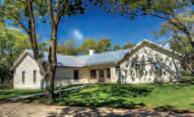
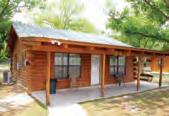










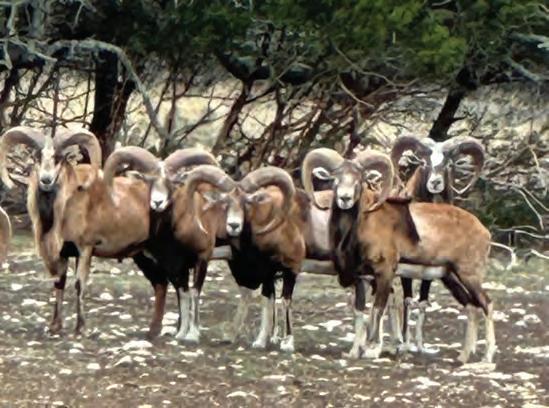

By Monica Allison
When looking to find property that has exotics there are many factors to consider. Edwards County is well known for the variety of free ranging exotics. There are also opportunities to purchase high fence ranches that are established or a piece of a high fence ranch that has already been stocked and managed. It is good to focus on a target species that is a favorite as different species prefer different terrain.
There are overlaps that exist and the larger property that you can get, the more likely it will be that you will have more variety in the topography. One of the advantages of being a part of a large high fenced development is there is potential for having more variety as long as it is properly managed and you don’t have to have as large of a piece to experience species diversity because all of the owners effectively share the game. There should be a management plan in developments like this and some people love that idea, and some want more independence on what they can harvest.
Once you have narrowed down a preferred species list, it is good to know what terrain and part of the county that species is more prevalent in. These are things that local realtors should have knowledge of and it is very beneficial to utilize their expertise. Axis and blackbuck are naturally grass eaters and prefer flatter terrain but also like to hide so they need some cover to feel comfortable. Aoudad and elk typically like steeper terrain and can have large territories. There are some properties that have valleys and hilltops and have quite the variety of species. Observing the natural vegetation will be useful to show what kind of animals will be drawn to the property, Persimmon trees are a good food source, and oak trees produce mast in the form of acorns to help them fatten up prior to the rut and winter. Oaks also provide browsing opportunities. Grass is needed for the grazers so having some nice pasture areas will attract axis. There hasn’t been an animal discovered that can survive on just rocks and cedar so good habitat is a great start
Water is a vital resource that will bring in all species, and specifically axis, who need to drink every day. If you are not able to establish a well immediately, a water catch system is a great way to set up water for animals and can be as simple as a water tote, a bowl with a float, and a structure above the tote with a metal roof and gutter system to fill the tote. If you are lucky enough to find a property that has it all, you’ll likely see many different species. Some properties are already set up and they should have game camera footage of the animals coming in. When looking at raw land, remember you can add water and feed stations. You can’t change location or the overall topography.
Once you’ve found the ranch for you, it’s time to get to work to make it the best place you can. You’ll never run out of things you can do. A survey of the property if possible would be ideal, getting clear boundaries marked will be an important first step. If the survey was ordered during the purchase, you can ask the surveyor to mark the boundaries clearly with flagging tape or stakes. In some cases there may not be a survey so meeting the neighbors is always a good step. Assuming the land is raw with no fences, blinds, feeders, or water, clearing some areas to set up stations to attract your target game is a priority. If there are game trails leading to bedding, feeding, or watering areas, that is a good way to find good spots to set up your stations. Make sure you are respecting the boundaries and it is always appreciated to not have blinds and feeders too close to property lines. Many developments have specific rules, but if you are outside a POA, it’s still the neighborly thing to do.
Most of all, relax and have fun. It will be a great learning experience and you will make memories to last a lifetime.








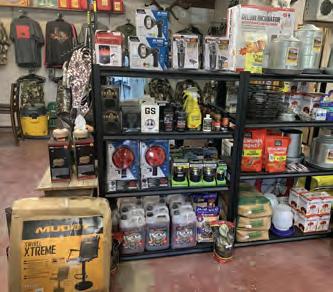





A small bear population is located in Western & Southwestern Texas and a few individual bears have been sighted in other parts of the state.

• Keep hunting camps clean to prevent odors that attract bears.
• Discard gut piles far away from campsites.
• Placing deer corn in piles or open feeders will attract more bears.
• Using an automated feeder hung out of reach of bears will decrease bear visitation.
• Switching bait from corn to soybeans will reduce bear activity.
• Planting food plots is best way to attract deer and avoid bear visits!
Electric fencing deters bears while allowing deer access to feeders. Feeders should be hung at least 8 feet high and 4 feet from the attachment point.
Hogs and bears can look very similar. Know your target! It is a violation of law to kill a black bear in Texas, with penalties of up to $10,000, added civil restitution fines, jail time and loss of all hunting privileges.
Hill Country
Never approach a bear!
• Bears are normally shy and not aggressive to humans.
• If a bear regularly visits your deer stand, scare it with rocks, a slingshot or air horn.
• If you encounter a bear at close range, talk in a calm manner while backing away slowly. Do not make direct eye contact.
• Do not run! This can trigger a bear’s chase instinct.
• If a bear approaches you, stand your ground and raise your arms, backpack or jacket to appear larger. Yell at the bear to scare it off.
• If attacked, fight back aggressively with anything available. Let the bear know you are not easy prey. Do not play dead.
• The black bear is a protected and rare species in the state of Texas.
• Male bears weigh 150 to 350+ lbs., and females weigh 120-250 lbs.
• Male home ranges average 20,000 acres, females average 5,000 acres.
• Denning can start as early and November and continue ‘til late May.
• Bears den in large, hollow trees, brush piles, thickets, rock crevices and caves.
• Denning bears go into a deep sleep but can be aroused if disturbed.
• Females mature at three to five years of age and, on average, have two cubs every other year
• Cubs are born in the den weighing 8 ounces and exit the den weighing 4 pounds. Cubs stay with their mother for 1-1/2 years.
• Bears are opportunistic feeders and eat almost anything available.
• Up to 90% of a bear’s diet is vegetable material, which includes nuts, fruits, berries and plants. Most of the protein in a bear’s diet comes from insects like beetles, wasps, termites and ants.
Call the Texas Parks and Wildlife Department at 800-792-1112.














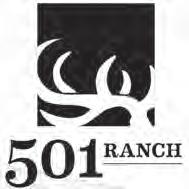
Discover an unforgettable hunting experience at the 501 Ranch in Uvalde, Texas. From thrilling hunts to refined comfort, our ranch combines South Texas adventure with genuine ranch luxury.
Hunting opportunities include:
• Dove
• Whitetail Deer
• Exotic Game
After a day in the field, unwind and enjoy the amenities that make 501 Ranch, unlike any other. Guests can relax in our private lodging, savor chef prepared meals, or spend the afternoon exploring the ranch.
Additional Activities:
• Skeet Shooting at the Range
• Bowling Alley & Game Room
• Guided “High Rack” Ranch tours to See Our Wildlife
Whether you’re here for a weekend hunt or a corporate retreat, the 501 Ranch team takes care of every detail – so you can focus on the experience.

Book Your Hunt or Private Stay Today. Uvalde, Texas 830-407-9501 Retreat@501Ranch.com













By Macy Ledbetter
By the time you read this, this article may not be useful for opening weekend but certainly will later in the season and perhaps down the road. First, let’s assume we are talking about elevated tower blinds so common throughout the Texas landscape these days. A comfortable elevated box blind will help conceal your movements and your scent while providing optimum visibility and a stable shooting rest.
Blind placement is critical, but so are the mechanics of a good box blind. The first order of business is pretty obvious—make it large enough to be comfortable and enclosed enough to conceal your movements. Honestly, camo clothing is not required to hunt elevated box blinds, but everyone does it.
Second, the window size and arrangement is critical for optimum visibility. If the windows are too high from top to bottom, your body movements will be visible from afar.
The height of the windows should be just enough to allow your scoped rifle easy access without hitting the frame. The length of the windows should offer a nice panoramic view of your surroundings so that you are not constantly shifting your body from side to side to peer outside. Windows that are long, skinny rectangles offer maximum visibility and concealment with minimum movement by the observer.
Having a dark background behind you also maximizes movement concealment and will keep you from being silhouetted by wary game. Sitting in front of the latched door, tucking into the corner or the use of dark fabric curtains will help in these regards.
Having a comfortable chair sounds too simple, but you might be surprised how many people still use five gallon buckets and rejected deer camp chairs in their blinds. A good quality chair will allow you to sit motionless and quieter much longer and therefore improve your chances for success. The chair height must also be coordinated with the window height to maximize visibility and minimize movement as well. And finally, considerations of WHO is to hunt with you are important.
If you plan to have others in the blind with you, they too will need space, concealment and a quality chair and it must meet their height requirements when it comes time to shoot out the windows. It doesn’t make sense to do everything right only to realize the hunter must sit on someone’s lap or on six phone books to get a shot off. These simple steps will make the hunt much more enjoyable and successful for everyone.
Blind placement is one of the most overlooked segments of deer hunting I regularly encounter. When selecting a location, don’t think like a human, but like that of a deer. Oftentimes, placing the blind for convenience is much different than placing it where it may offer the best chance for success. Deer, particularly mature bucks, use travel corridors — edges, drainages, creeks, tree lines and other screening
covers — to get from one place to the next. Outside of the rut and the brief lapse of intelligence, mature bucks stick close to such landscape features to offer maximum concealment as they travel.
A well placed blind will be able to observe these corridors, perhaps more than one simultaneously, at a safe enough distance to avoid detection by the quarry yet offering a high percentage shot.
Placing the blind too close to travel or feeding locations such as feeders or food plots will disrupt the animal’s daily routine and significantly reduce success.
Feeders should be placed to offer protective cover to and from them as well. Feeders in the wide open offer no such protection and create deer activity only under the cover of darkness.
Obviously, prevailing wind direction must also be taken into consideration. Cross or down wind from travel and feeding areas will ensure the best chance of success and such locations must only be hunted when the winds are favorable. Hunting these locations when the winds are “not right” will only educate the animals and make them more wary of the area.
Outside of the rut, most mature bucks will approach a feeding location downwind to scent-check the area for danger and for receptive does before exposing themselves. If your blind is too close to the feeder, the buck will approach downwind of you as well as the feeder and you will be busted. If your blind is too far, you won’t be able to make an accurate shot.
Since “how far is too far” is highly variable, try to take into account your actual abilities and place the blind as far away from the feeder as you can confidently make the shot.
An often overlooked part of deer blinds is anchoring them to the ground. The winds are not always calm in Texas, so making sure your blind will be there next hunting season is a must.
Tie-downs, anchors, guy wires, concrete posts and t-posts are required to not only keep your blind upright, they will also help keep the blind steady when the moment of truth arrives and you have to make the shot.
There is an unwritten rule among ethical hunters and landowners that states that no hunting blind will be placed along property lines. The appropriate distance requires common sense based on topography, habitat, line-of-sight and shooting direction.
The same holds true for feeder placement.No neighboring landowner should be able to see your feeders or blinds and you should not be able to see theirs.
If your property is small and irregular shaped, hunt only the center and perhaps a tower blind is not for you. If your property is large, concentrate on travel corridors away from the boundary line and out of sight of the neighbors. Common sense and blind location not only makes hunting a safer and more enjoyable endeavor, but makes for much better neighbors as well.



At first light, you feel it in your bones and in the land beneath your boots. The mesquite brush holds its secrets, the air is cool and sharp, your breath steady, your senses alive, and the call of the hunt is woven into the quiet beauty of Uvalde County.
By James Bigley
The black bear population in Texas has been a subject of interest for many wildlife enthusiasts and researchers. A small breeding population has found its way back into the heartland, specifically reestablishing itself within the Chisos Mountains situated at Big Bend National Park. This park is renowned as a hub for diverse wildlife, including our furry friends who tip the scales between 200300 pounds. Sightings are now reported annually across various mountain scapes throughout this southern state. Yet it’s not just their robust weight or unique fur that makes them intriguing but also their ecological role within our natural environment.
Black bears play an integral part in balancing nature’s intricate web. They contribute significantly towards seed dispersal thanks to their diet primarily composed of fruits and nuts during certain seasons. Besides being ardent hikers covering vast territories each year, they help regulate populations by preying on animals such as deer fawns and elk calves. By keeping herbivore numbers checked, they prevent overgrazing which ultimately protects vegetation diversity.
This vital role extends beyond forest ecosystems too. Their extensive burrowing habits create homes for countless species while their droppings act as excellent fertilizers promoting nutrient recycling

– truly nature’s own waste management system. Black bears are making a comeback in Texas, showing their resilience against past hardships. Their resurgence is most notable in West Texas and Big Bend National Park where sightings have increased. Despite the harsh desert climate of the Trans-Pecos region and sporadic reports from East Texas, these furry creatures are reestablishing themselves across the state.

Through crowd sourcing data (sightings confirmed by Texan hunters, ranchers, and outdoor enthusiast) James Bigley Ranches has one of the most up to date databases of reported black bear sightings and the current Texas black bear range anywhere. Below is an up to date black bear in Texas map of counties and sightings of the black bear range in Texas. Red star is a confirmed sighting. As you can see black bears are moving to the Edwards Plateau region even as far as Uvalde Texas, Eastern Texas, and so on. Please refer to the live interactive map below in addition that is updated at least four times a year.
You’ll know a black bear when you see one. Weighing between 200-300 pounds, they’re not exactly subtle creatures. Their fur is long and coarse, often jetblack but can sometimes be cinnamon brown. The front claws are generally longer than hind claws – an interesting fact that differentiates them from other bears. They aren’t just opportunistic eaters; their diet varies greatly depending on location, season, and availability. While there has been some debate about whether black bears pose any significant threat to humans – incidents where they injure humans are extremely rare.
As far as reproduction goes – it’s pretty fascinating, too. Bear cubs wrestling is a common sight during springtime as part of their learning process.These cubs will stay with momma bear until she begins breeding again, usually after a year and a half. This is an essential period for the cubs to learn survival skills.
Back bears are complex creatures with unique characteristics that set them apart from other wildlife in Texas. When you visit our parks or see these creatures in your own backyard, it’s crucial to respect their space. Always remember to keep a safe distance and enjoy observing them from afar.
The Texas Parks and Wildlife Department (TPWD) plays a crucial role in managing black bears, through studying their populations, habitats, behaviors, and potential threats. TPWD also educates the public about coexistence with these large mammals. Conflict management strategies include bear-proof dumpsters to keep
See BEAR, page 55
BEAR, from page 54
neighborhoods clean and safe. Above all else though, it’s essential for us to remember that living harmoniously with black bears is not just possible but critical for maintaining biodiversity.
Comparing Black Bears in Texas to Other Bear Species
Texas black bears contrast with their relatives like the Louisiana black bear and other species, such as grizzlies, polar bears, browns and American blacks. The differences lie not just in physical attributes but also behavioral patterns.
The American black bear (Ursus americanus), which includes both the Texas and Louisiana sub-species, is generally smaller than its counterparts. Weighing between 200-600 pounds for males while females usually weigh less. Their fur color can range from pure white through chocolate-brown to jet-black.
Meanwhile, Louisiana Black Bears, a subspecies of the American Black Bear, has slightly different characteristics including longer skull shapes and proportionately larger molar teeth.
Distinguishing Physical Traits
Grizzly or brown bear (Ursus arctos), native to North America, stands out with humped shoulders and long claws that help it dig up roots or pry apart logs to find food. They are substantially bigger compared to Texas’ Ursus americanus, weighing around 500-900 pounds for males.
Niche Preferences & Behaviors
Bears show preference towards specific habitats too. While our Texan friends prefer forested landscapes and river valleys, Louisiana black bears love hardwood forests. Polar Bears? They’re ice lovers.
Black bear behavior can also vary by region and species. For instance, the Texas Black Bear is known to be relatively docile unless threatened or protecting cubs.





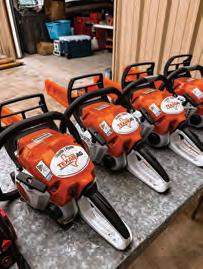








Depends on who you ask. Scientifically speaking, the phases of the moon have no influence on doe or buck movement. Talk to any seasoned hunter, though, and you just might get a different story. During the full moon, for example, hunters have observed deer seem to be more active at night. Better visibility in moonlight makes spotting and tracking whitetails easier, and chances are, you’ll see more of them.


The phase when the Moon appears to be fully illuminated from Earth’s perspective occurs when the Sun, Earth, and Moon are all in alignment, forming a straight line. The Moon and the Sun are on exact opposite sides of the Earth. From this position, the Sun’s light shines directly onto the portion of the Moon visible to us and creates a full, bright circle of light. Even though the exact peak may occur in daylight, the Moon appears round and bright for about a day before and a day after, so you can enjoy a visually “full” moon the night before and the night after the official peak.



Members of the red oak group, particularly Texas red oak (aka Spanish oak), Shumard oak, blackjack oak, and water oak are the most susceptible of the fungus and may play a unique role in the establishment of new oak wilt infections. Red oaks never survive oak wilt and often die within 4 to 6 weeks following the initial appearance of symptoms. During summer months, diseased red oaks can often be spotted from a distance because of their bright, autumn-like coloration in contrast to the surrounding greenery. This symptom is called flagging.
Live oak and Texas live oak are intermediate in their susceptibility to oak wilt, but are most seriously affected due to their tendency to grow with vast, interconnected root systems that allow movement of the fungus among adjacent trees. Most live oaks defoliate and die within 3 to 6 months following initial appearance of symptoms. Some live oaks take longer to die, and a few untreated trees may survive many years in various stages of decline. Occasionally, a few live oaks in an oak wilt center may escape infection and remain unaffected by the disease.
Members of the white oak group include post oak, bur oak, Mexican white oak, white shin oak, Durand oak, Lacey oak, and chinquapin oak. Although white oaks show some tolerance of the disease, all oaks can be infected by the fungus. White shin oak, Lacey oak, and chinquapin oak can grow in stands with interconnected root systems, enabling the fungus to possibly infect adjacent trees are susceptible to the fungus. Many infected white oaks will exhibit some canopy loss and generally the disease will not spread to adjacent trees. Lacey oaks, white shin oaks, and chinquapin oaks sometimes form root connections similar to live oaks, offering a pathway for the disease to spread to adjacent trees, causing higher infection and mortality rates than in other white oak species.



Early detection and prompt action are essential for successful management of oak wilt. The specific measures taken depend on several circumstances but should include appropriate combinations of the following:
• Remove and dispose of oak wilt-infected red oaks immediately.
• Avoid wounding oak trees, including pruning, from February through June.
• Paint all wounds/fresh stumps immediately regardless of season.
• Red oak wood suspected of infection should not be stored.
• Plant trees native and/or adapted to your area. Find those at texasoakwilt.org/resources/recommended-trees
• Favor a diversity of tree species.
• Avoid wounding oaks during planting.
• Find the right tree for your property.Use the Texas A&M Forest Service guide at texastreeplanting.tamu.edu.
• Install a trench at least 4 feet deep and 100 feet beyond the perimeter of infection centers (last symptomatic tree) to break up root connections.
• Cut or uproot all trees within the 100-foot barrier (except those injected with fungicide).
• Find trenching vendors at texasoakwilt.org/getting-help/vendors.
• Identify susceptible, high-value oak trees in proximity to expanding oak wilt infection centers.
• Consult a trained and licensed arborist (with certified applicator’s license) for treatment of susceptible trees with injections of propiconazole.
• Find injection vendors at texasoakwilt.org/getting-help/vendors.


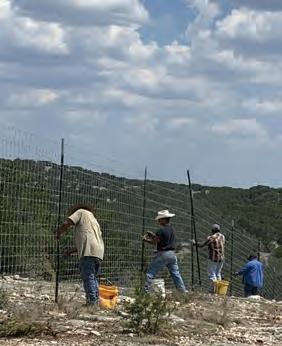






Every year your local Fire Department responds to controlled burns that have not been reported. It is your responsibility to call in when burning on your property, before you burn.
• If you’re burning over several days, call in each day.
• Clear an area of 10-15 feet around the burn site and do not leave the fire unattended.
• Keep the fire small enough so you can control it. Call the dispatch if you think you need help! It’s better to be safe than sorry.
• Maintain a means of communication at the site if possible (cell phone, etc).
• Have a plan to extinguish the fire (garden hose, buckets of water, flat shovel).
• When done, make sure the fire is completely out and call Dispatch to inform them the burn is complete at 830-683-4104.
If you have questions, please call Fidel Moreno, RECVFD Fire Chief at 830-683-2504.

In August 2015, Edwards County was devastated by a Wildfire, The Brown Ranch fire scorched nearly 18,000 acres in its destructive path for over a week. Multiple State Agencies assisted the Texas Forest Service and Texas Intrastate Fire Mutual Aid System Strike Teams and a helicopter were deployed to support fire suppression activities. The county issued a Local Disaster Declaration.
A large part of Edwards County was under a mandatory evacuation as the fire was fast approaching when the winds shifted and subsided, saving many property owners the loss of most everything in the fires path.
Thanks to Gib, Danny and Richard Flores, owners of the ranch where these photos were taken.

B Happy Store/Hunt Bros. Pizza 31363 N US 83, Concan • 830-232-6910.
Barksdale Coffee Company 25775 S. Hwy. 55, Barksdale • 830-282-1616.
Bear Creek Fudge & Chocolate 118 S Nueces (Hwy 55), Camp Wood • 830-597-6160.
Ben & Company Shell Station/ Hunt Bros. Pizza 100 Uvalde Rd, Rocksprings • 830-683-4470.
Canyon BBQ & Grill 107 N Nueces St., Camp Wood • 830-597-2333.
Casa Falcon Mexican Restaurant 2nd Street, Camp Wood • 830-597-5111.
Gypsy Sally’s 373 US-83, Leakey • 830-260-1001
Hog Pen on 336 BBQ 674 RM 336, Leakey • 210-288-3995
Isaack’s Restaurant 1606 Main St, Junction • 325-446-2629.
Junction Burger Company 1907 Main St, Junction • 325-446-2695
Kingburger Drive Inn 102 N. State Highway, Rocksprings • 830-683-4127.
Lotus Thai Café 103 W. Main Street, Rocksprings • 830-683-3711.
Lum’s BBQ 2031 Main St, Junction • 325-446-3541
Mama Chole’s 234 US-83, Leakey • 830-232-6111
Mill Creek Cafe 849 S US Hwy. 83, Leakey • 830-232-4805.
Miss Buffy’s Casseroles, Pies, etc. Call or text to order. 830-507-9171.
Oasis Outback Salad Bar & Grill 2900 E Main, Uvalde • 830-278-4000
Pineview Coffee Company 205 E Main, Rocksprings • 830-460-9298.
Sonia’s Tacos 304 E. Main, Rocksprings • 830-834-0037.
Texas Scratch Kitchen West Bear Creek (Junction), Shortstop (Menard), Murphy Creek Cellars (Mason), Venison World (Eden). 325-396-8307, TexasScratchKitchen.com.
The Chicken Coop Grill 25607 TX-55, Barksdale. 830-234-3244.
The Jailhouse Bar & Grill 108 W Austin St, Rocksprings • 830-683-3366.
The Milky Way 1619 Main, Junction • 325-446-2215
The Tamale Lady Year-round. Call to order 303-564-2180.






New home builds starting at $300K & up to $5M+ within a 100-mile radius of Hondo TX, such as Boerne, Comfort, Kerrville, Bandera, Castroville, Devine, Uvalde. “We’re not into boring and plain designs. We’re all about making homes that fit your lifestyle perfectly.”




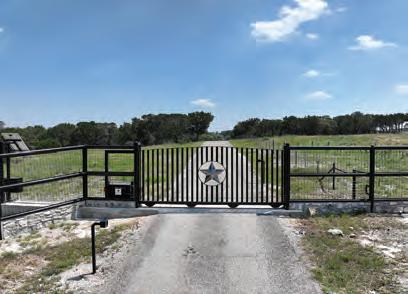



Claude H. Gilmer Memorial Library
308 US Hwy. 377, Rocksprings, Texas Computers, Free WiFi 830-683-8130
Rocksprings TX Hunting & Property Owners FaceBook Group www.facebook.com/groups/367594347352600/
Rocksprings Kimble Hospital Medical Clinic
Tuesday and Thursday 9am - 4pm Friday 9am - 2pm 212 W. Main Street, Rocksprings, TX. 830-308-7734
Air MedCare Network Membership Swift access to emergency care you need with transport services. 830-928-1226, 800-793-0010
Sonora Animal Hospital, Dr. Gene Gibbens 2300 N. Service Rd, Sonora, TX. 325-387-2481
Town & Country Veterinary Hospital 2710 Junction Hwy., Kerrville, TX. 830-367-5316.
Junction Veterinary Clinic 102 Bluebonnet Dr. Junction, TX. 325-446-2776.
Barksdale 25594 TX-55, Barksdale, TX. 830-234-3617.
Camp Wood 309 Nueces St, Camp Wood, TX. 830-597-3262.
Rocksprings
102 W Bandera St, Rocksprings, TX. 830-683-2143.
Sheriff & DPS Dispatch
Sheriff James W. Guthrie • Chief Deputy Danny Irwin 830-683-4104.
Edwards County EMS Rocksprings 830-683-3305.
Barksdale Edwards County 830-234-3473.
Camp Wood Real County 830-597-6100.
RECVFD Rocksprings Edwards County FD 830-683-2504.
Texas Parks & Wildlife Game Warden Blake Satterfield 830-776-6219
Texas Parks & Wildlife Biologist Ryan V Schmidt 830-703-6808.
Agriculture Extension Agent James Crockett, 830-683-4310.
Edwards County Chamber of Commerce edwardscountychamber.org 830-683-6466.
Edwards County OEM
Jim Glasscock, Jordan Aguilera 830-683-5117
US Agriculture Department 830-683-2187.
US Homeland Security Border Patrol Rocksprings 830-683-2255.
US Natural Resources Conservation Service 830-683-2125


































